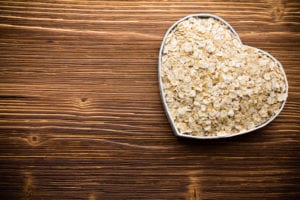Written by Chrystal Moulton, Staff Writer. Histological examination following four weeks supplementation with high molar mass oat beta-glucan showed a reduction in inflammation.
 Beta-glucans are the soluble part of dietary fiber found in the cell wall of fungi, yeast, algae, and cereals 1. It is a polysaccharide possessing immunomodulating 2, 3 and anti-inflammatory 4 properties. Since beta-glucans do not degrade in the stomach, it creates a mucus layer that protects the inner lining of the stomach from irritation and alleviates inflammation 5 . However, few studies have demonstrated its effect in the case of gastritis. In the current trial, researchers tested the effect of high and low molar mass beta-glucan sourced from oats on individuals with gastritis within the gastric antrum 1 .
Beta-glucans are the soluble part of dietary fiber found in the cell wall of fungi, yeast, algae, and cereals 1. It is a polysaccharide possessing immunomodulating 2, 3 and anti-inflammatory 4 properties. Since beta-glucans do not degrade in the stomach, it creates a mucus layer that protects the inner lining of the stomach from irritation and alleviates inflammation 5 . However, few studies have demonstrated its effect in the case of gastritis. In the current trial, researchers tested the effect of high and low molar mass beta-glucan sourced from oats on individuals with gastritis within the gastric antrum 1 .
In this parallel-group, randomized, double-blind, placebo-controlled study, 129 participants (aged 23- 74 years old) undergoing elective endoscopy due to dyspepsia were recruited. All participants underwent a physical examination and screening at baseline. Patients with an initial diagnosis of gastritis in the gastric antrum were invited to participate in this study. Participants were randomized to receive potato starch, high molar mass beta-glucan, or low molar mass beta-glucan. All treatment protocols were provided at an oral dose of 100mL of 3% of the assigned solution which was taken twice daily (3g per day) for 4 weeks. Participants were instructed to consume the assigned supplement 15 to 30 minutes before breakfast and dinner. They were not allowed to take any drugs one hour before or after dosing. Participants in the treatment study groups were not allowed to take any fiber supplements during the study and diet was standardized to an easily digestible diet without beta-glucan products during the treatment. Participants were also required to attend four scheduled clinical visits:
- Visit 1- Screening
- Visit 2- Baseline assessment
- Visit 3- End of treatment assessment
- Visit 4- Follow-up two weeks after completing the treatment
At visit two and three, blood and stool samples were collected, and an endoscopic and histopathological examination was conducted.
Forty-eight eligible participants were randomly assigned to one of three groups with 16 patients in each: high molar mass beta- glucan group (G1), low molar mass beta-glucan group (G2), or placebo group (potato starch). Histological examination following four weeks supplementation with high molar mass oat beta-glucan showed a reduction in inflammation demonstrated by decrease in lymphocytes and neutrophils in the mucosal tissue. No statistically significant changes were observed in the other groups. C- reactive protein concentration significantly decreased following only low molar mass beta-glucan consumption (P <0.02). Glutathione peroxidase and glutathione reductase were significantly decreased in both the low and high molar mass beta-glucan (P <0.05) after four weeks. Concentration of acetic acid, propionic acid, and hydroxybutyric acid increased in participants consuming beta-glucan (P < 0.01).
Further analysis showed that short chain fatty acids, particularly acetic acid and propionic acid, along with glutathione peroxidase and glutathione reductase were significantly affected by the beta-glucan treatment following four weeks of consumption. The most common adverse events during the trial were dyspepsia, upper pulmonary tract infections, increase in arterial pressure, and upper abdominal pain/ discomfort. Symptoms were usually mild and, in some cases, disappeared within a few days. No significant difference was observed in the subjective assessment of well-being of participants during the study.
Overall, supplementations with oat beta-glucan for four weeks improved immunological and oxidative parameters and short chain fatty acid concentration in the stool of participants with gastritis. Slight improvement in histopathological changes were observed in participants assigned to the high molar mass beta-glucan group. Mild adverse symptoms were observed following consumption of oat beta-glucan. However, clinical symptoms were not exacerbated by the treatment. Further studies will be needed to confirm these results.
Source: Gudej, Sylwia, Rafał Filip, Joanna Harasym, Jacek Wilczak, Katarzyna Dziendzikowska, Michał Oczkowski, Małgorzata Jałosińska, Małgorzata Juszczak, Ewa Lange, and Joanna Gromadzka-Ostrowska. “Clinical Outcomes after Oat Beta-Glucans Dietary Treatment in Gastritis Patients.” Nutrients 13, no. 8 (2021): 2791.
© 2021 by the authors. Licensee MDPI, Basel, Switzerland. This article is an open access article distributed under the terms and conditions of the Creative Commons Attribution (CC BY) license (https:// creativecommons.org/licenses/by/ 4.0/).
Click here to read the full text study.
Posted October 18, 2021.
Chrystal Moulton BA, PMP, is a 2008 graduate of the University of Illinois at Chicago. She graduated with a bachelor’s in psychology with a focus on premedical studies and is a licensed project manager. She currently resides in Indianapolis, IN.
References:
- Gudej S, Filip R, Harasym J, et al. Clinical Outcomes after Oat Beta-Glucans Dietary Treatment in Gastritis Patients. Nutrients. Aug 14 2021;13(8)doi:10.3390/nu13082791
- Pan W, Hao S, Zheng M, et al. Oat-Derived β-Glucans Induced Trained Immunity Through Metabolic Reprogramming. Inflammation. Aug 2020;43(4):1323-1336. doi:10.1007/s10753-020-01211-2
- Vetvicka V, Vannucci L, Sima P. β-glucan as a new tool in vaccine development. Scand J Immunol. Feb 2020;91(2):e12833. doi:10.1111/sji.12833
- Laroche C, Michaud P. New developments and prospective applications for beta (1,3) glucans. Recent Pat Biotechnol. 2007;1(1):59-73. doi:10.2174/187220807779813938
- Tanaka K, Tanaka Y, Suzuki T, Mizushima T. Protective effect of β-(1,3 → 1,6)-D-glucan against irritant-induced gastric lesions. Br J Nutr. Aug 2011;106(4):475-85. doi:10.1017/s0007114511000365
